PARISH OF SEAGOE
by Frank McCorry
The Parish of Seagoe forms part of the Barony of
Oneiland East and lies due south of Lough Neagh with the Upper Bann as
its western boundary. In its original form, Seagoe was extensive,
stretching from the Bann bridge, at Portadown, to Silverwood, on
Lurgan's town boundary, a distance of six miles. From Hacknahay, in the
south of the parish, to Ardmore,in the north, is eight miles. Until the
end of the 18th. century, Seagoe took precedence within the Dromore
Diocese over Shankill Parish perhaps on account of its greater antiquity
as a religious foundation. Even today while gazing from a distance
within Old Seagoe graveyard towards the mound on which the old church
ruin stands, the outline of the large double-ringed rath, which formed
the nucleus of the original foundation, remains visible. David Riley
stated that Seagoe was one of the most ancient Christian settlements in
Ireland, dating from c.540 A.D. A large stained glass window in Seagoe
Church of Ireland depicts Saint Gobha who is attributed with the
foundation of the site. The Reverend Bernard J. Mooney wrote, concerning
Saint Gobha:
Reeves was the first modern scholar to perceive that
the last element in the place-name is a saint's name, Gobha. Nothing is
known of this St. Gobha beyond the fact that he was associated with
ancient Seagoe (probably as its founder). The fullest reference to him
is that given by Colgan citing the Calendar of Cashel, where his name is
Latinised Gobanus. The passage may be translated: `St. Gobanus of
Killamery (Co. Kilkenny), near the mountain called Slievenaman; or else
Gobanus (Goba) of Teg da-goba (Seagoe), on the bank of the Bann, in
Iveagh of Ulidia. Whichever of these it is, he was the (spiritual)
father of a thousand monks' (Colgan, A.SS.,750b).
Patrick Keenan added that `information about the
ecclesiastical history of Seagoe prior to the l7th.century is woefully
scanty. Indeed, from the days of St.Gobha until the year 1406, not even
the name of one of his successors as pastor has been discovered'. In
1440, the income from Seagoe Parish was so small that it could not
support a parish priest, so it was united to a neighbouring parish,
Enachloisgy, the two parishes being described as being at a moderate
distance from each other and insufficient to support two pastors. Fifty
years later, in 1492, further consolidation of parishes was approved,
and Seagoe (Taydagoba), Shankill (Kylmilan) and Aghalee (Acadle), were
united. Shankill and Seagoe remained united, under Catholic aegis, from
1492 until 1788.
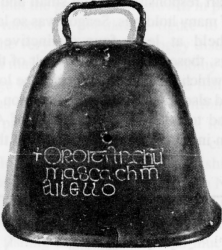
The Bell of Seagoe, one
of four names attributed to the above bell. The inscription in Irish
assists in approximating the age of the bell, and to speculate on
the background of its keepers. The inscription, 'Oroit ar Chumascach
m Ailello' - A prayer for Commascach son of Ailill. The death of
this Cumascach, the Economist of the Cathedral of Armagh, is
recorded in the Annala Rioghachta Eireann at the year 904, which
might infer that the bell is eleven hundred years old this year.
Cumascach's mother, Gormlaith, was a daughter of Murdach, King of
Ulster. The Bell of Seagoe was kept in the parish for approximately
one hundred years, 1730-1830, and is now on display in the National
Museum of Ireland, Dublin, alongside the Bell of Saint Patrick.

The vicarage of Enachloisgy is now not known but on Oxford Island, in
the townland of Annaloiste, the remains of an ancient church and
cemetery were uncovered in 1968, and excavated by the archaeologist, Pat
Collins. It was most interesting to discover in Seagoe Church of Ireland
parish registers that right up until the middle of the 19th.century,
some families from Annaloiste were marrying and baptising in Seagoe,
some four miles distant, although the spire of Shankill Church, in
Lurgan, was well within sight from their homes. This may well have been
the result of rural parish allegiances formed two centuries earlier.
Under Catholic aegis, bonds of unity between Seagoe
and Shankill were always strong, and socioeconomic and ecclesiastical
associations always close. This was particularly true during the 19th.
century when two illustrious parish priests, Reverend Laughlin Laurence
Morgan, in Seagoe, and Reverend William O'Brien, in Shankill, worked
tirelessly and effectively for almost half a century in their respective
parishes to raise living and moral standards. Each parish was heavily
populated; each parish needed
churches and schools; each catered for a considerable
number of poorer families, and kinship links bound the districts
together. When the Great Famine came, Seagoe and Shankill, for a variety
of reasons fared better than most parishes during that period of great
distress and high mortality.
In Seagoe, the weaving of linen and associated trades
were widely practised. This often took the emphasis off agricultural
improvements. This in turn was in part responsible for the small and
fragmented nature of many holdings. Seagoe was so large a parish that it
held at least four distinctive population groupings, these arising as
the result of the nature of the land which differed much from one
locality to the other, and also from the major population adjustments
which had to be made in the wake of Anglican in-migration in the
1670-1710 period, and the aftermath of the Battle of the Diamond in
1795.
On the southern Lough Neagh shore, east of the Upper
Bann, the district known as 'the Montiaghs' - from the Irish, Montiagh
Ruadh (the Red Bog), comprised almost 6,000 acres in ten townlands.
Subject to severe winter flooding every year, the Montiaghs held almost
half of Seagoe's Catholic population, emanating from families which had
occupied the larger area of Clanbrassil for hundreds of years.
Turf-cutting, fishing, weaving and pocket-farming sustained these
families throughout the 18th. and 19th. centuries. When the Great Famine
came, this district, in spite of obvious disadvantages, increased in
population during that destructive decade, and went on to register a
substantial population increase over the following ten-year period.
Marriage and marriage numbers can often be good indicators of the extent
of well-being or the lack of it within a parish. In 1847, the most cruel
of the Famine years, only seven Catholic marriages were solemnised in
the whole of Seagoe Parish.
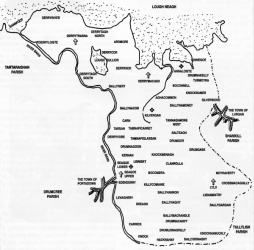
Probable townland
composition of the original Seagoe Parish. The four churches of
the modern era are marked. So also are the three ancient
foundations of Annaloiste, Kilvergan and Old Seagoe.
The greatly diminished marriage number for 1847 is
not unexpected. A mere seven marriages in the entire parish means that a
sense of dread and vulnerability had spread throughout the extensive
parish. Those which were solemnised took place towards the latter part
of the year. In later years, right up until the middle of the 20th.
century, it was the aim in the Montiaghs to have some new potatoes dug
before the end of July. This may have had some relevance to
late-in-the-year weddings. It should also be said that Montiagh Church
of Ireland marriage numbers were equally curtailed.

However, the main feature of Seagoe Catholic marriage
numbers is the scale and rapidity of the recovery in marriage numbers
from 1849 onwards. The mid-summer figures for 1850, and the `high' of 45
marriages in 1853, do not at first reading appear to characterise the
Irish parish of the post-Famine period. Marriages were celebrated as if
the Famine period had been consigned to history and that life was
unaltered. S.H. Cousens may have found a parallel elsewhere; he stated
that something of the pre-Famine demographic pattern survived in the
poorest and least fertile parts of western Ireland. This same approach
to survival may also have been adopted locally. For the time being,
Montiagh and Seagoe people may have placed their trust in their cluster
of material supports which comprised the availability of turf, fish and
wild fowl, as well as the dearly-bought benefits of cottage linen
weaving. Thus, the weddings continued, in even greater numbers than
before.
The net result was that in the Montiaghs, the
district's population increased from 3,581 people, in 1851, to an
extraordinary figure of 4,338, in 1861. No new industries came; no new
development schemes were initiated. All that happened was that no
adjustments were made to the demographic approach of the pre-Famine era.
Burial numbers were down. The weakest had gone (in the Montiaghs, mainly
the elderly). Following on from increased marriage numbers, baptisms
rose accordingly. And then two decisive factors came into play. Firstly,
a set of poor harvests set in, brought about by six years of adverse
weather conditions. Secondly, the need or desire to seek a better life
elsewhere was felt in Seagoe, and in the Montiaghs, particularly. Rural
depopulation began in earnest, its magnitude disguised by decadal census
figures.
The adverse weather conditions were:
-
1859: heavy rains, severe drought, heavy rains;
-
1860: heavy rains;
-
1861: heavy rains, worse than the previous year;
-
1862: heavy rains, very wet and cold;
-
1863: severe drought, then torrents of rain;
-
1864: intense drought throughout the summer.
These unfavourable conditions compounded the major
disadvantages which prevailed on the Montiaghs even in an average year.
This contributed greatly to a 33% increase in burial numbers during the
period 1859-64, using 1856-58 as the mean. An exodus from the district
began almost immediately. It is probable that the post-Famine growth in
population which had raised the population figure to 4,338 in 1861, was
the very limit which a boggy district could support on a mainly
small-holding economy bolstered up by cottage weaving, turf digging and
fishing.
There was a strong fishing tradition in the Montiaghs,
particularly among Catholics. Its strength during the mid-19th. century
period cannot be quantified. In the early 1900s, nineteen fishing boats
operated from the Bay Shore, in Derrytagh North and Derrytrasna. Eels,
pollan and trout were the main catch. The pollan season ended at
Hallow'een, and the penalty for fishing after this date was much feared.
However, pollan could be part of the winter diet, preserved by a simple
and effective method. Just prior to Hallow'een, a considerable part of
the pollan catch was gutted, and the fish strung out through a scallop
(a willow rod) which was put through `the eye', i.e. through the gill to
the mouth. The scallop was then wedged into the large open chimney where
the fish were dehydrated and smoked, becoming hard and black in colour.
It is remarkable that throughout this difficult
period, Catholic and Church of Ireland marriage trends were quite
similar. The post-Famine rapid recovery of both communities could not
have been anticipated. Neither could the continuation of high marriage
rates until c.1860 have been predicted. The attitude of the people had
manifested little change. Neither had the terrain, in spite of Lough
Neagh's winter level being somewhat lower. Flooded fields and wet
turf-banks remained. Church of Ireland farms were generally larger and
on higher ground and this can partly explain a decadal recovery in
Church marriage numbers during the 1860s. The exodus from the Montiaghs
in the 1860s is more clearly reflected in the marriage numbers than in
census figures. Obviously those of marriageable age departed in
considerable numbers. Yet, in 1871, the district remained heavily
populated, to an even greater degree than it had been in the immediate
pre-Famine era (based on the census figure of 1841). A strategy was
slowly unfolding to combat poverty, and its implementation was proof, if
proof were needed, that widespread poverty remained in the district.
The strategy involved relocation, in particular to
Derrytagh North, a small townland of almost virgin bogland joined to
Lough Neagh by a sandy foreshore.
Derrytagh North had no separate identity until the
later-19th. century period. In spite of its size and the nature of its
ground, the townland's population was given as 625 in 1871, this being
16% of the overall district's population, dwelling on a mere 4% of its
area. This was the result of a population increase of 45% in 1841-51,
followed by a 78% increase in the following decade. Those who moved,
many from Ballynery, firstly dug down through the turbary to a
considerable depth, and then worked this reclaimed land in very small
holdings of roughly one acre in extent. The townland was criss-crossed
by narrow roads and ramparts, and was the centre of the district's
fishing community. Even with a basic supply of food, and fuel literally
underfoot, it was inevitable that people would leave Derrytagh North,
and by 1881, the population had declined to 541, the total house and
land valuation of the townland being merely �249.

ST. PATRICK'S CHURCH, AGHACOMMON
(or DERRYMACASH CHAPEL)
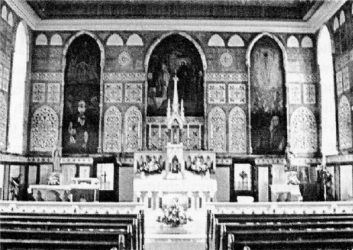
The impressive Sanctuary of
St. Patrick's Church. Although it is not possible to specify when the
reconfiguration of the interior took place, the sanctuary was originally
located and what is now the back of the church. Thus, unusual for a
church of the period, there is now no window directly behind the altar,
the 'Sanctuary Windows' instead are high up behind the organ gallery
above the church entrance. However, the sanctuary is embellished by
sacred paintings and colourful mosaics.
Seagoe was unique in one respect - it was the only
parish in the Dromore Diocese which contained four Catholic churches.
The histories of these churches illustrate the many sacrifices made by
parishioners during the nineteenth century. St. Patrick's Church stands
in the townland of Aghacommon, built there in 1834, but it is often
known as Derrymacash Chapel. Local tradition places the siting of the
first Derrymacash Catholic Church on Lark's Hill, in Raughlan demesne,
and indicates that its origin would have been before the Plantation.
Workmen digging shores in Raughlan discovered a path four feet below
ground level consisting of large wooden planks, similar to railway
sleepers, laid about eighteen inches apart. The line of the path
according to their limited excavation was from Lark's Hill to Oxford
Island.
It was therefore assumed that the path was a
traditional route linking two church sites, namely the early church at
Lark's Hill, and the church at Oxford Island, which Brownlow found
roofless on his arrival in these parts, in 1610. What the workmen may
not have known was that this same path continued across the main
Derrymacash road and onwards to the River Bann. This does not destroy
the workmen's theory but it also may point to a short transport link
existing from Lough Neagh to the River Bann across reasonably good
ground, something virtually impossible in the rest of the Montiaghs.
At the beginning of the nineteenth century a small
Mass-house stood on the site of the present Parish Church of St.
Patrick, in Aghacommon, which owes its erection to the work of Father
John MacLeigh, appointed parish priest towards the end of 1826. The site
was obtained from the Brownlow family at the end of the eighteenth
century, and the Fforde family of Raughlan, is said to have supplied the
timber for the roof. In 1913-15, the sanctuary was decorated in marble
by the late Archdeacon MacCartan, while notable improvements were
executed during the pastorate of Canon Magee. This work had the
wholehearted support of parishioners, several of whom were extremely
generous in their donations. Gifts on the occasion included a new marble
high altar, presented by Mr. Patrick MacGreavy, the altar of the B.V.M.,
donated by Mrs. Casey and family, and the altar of St. Patrick, the gift
of several subscribers whose names are preserved on a list inside the
tabernacle. The Stations of the Cross were presented by the late Mrs.
MacCann and family, Ballinery. Renovations to the exterior of St.
Patrick's, in 1952, included the resurfacing of the surrounding paths
and the landscaping of the grounds.
On Sunday, August 11th. 1959, His Lordship, Most
Reverend Dr. Eugene O' Doherty, solemnly blessed the new extension to
the cemetery. The church roof was felted, relathed and reslated, in
1976. In the second quarter of 1977, construction work began on the now
impressive bell-tower. On Sunday, February 5th. 1978, the bell was
blessed, named Patrick, raised to its position and rung for the first
time. The related ceremonies began at 3.00 p.m. and consisted of Rosary,
Sermon, Blessing of Bell, and Benediction. In the church porch, a plaque
now reads - Pray for the Donaghy family, through whose generosity this
tower with its bell was erected. (The Donaghy family, originally from
Drumnagoon, and who are now all deceased, owned an extensive farm which
adjoined the church grounds). Also in the church porch is a quite
beautiful pane of incised glass which depicts the ancient Bell of Seagoe.


St. Patrick's
Church, Aghacommon, (often referred to as Derrymacash
Chapel), is the mother church of Seagoe Parish. The church
was erected during the pastorate of Reverend John McLeigh,
1826-31, described as 'one of the finest Dromore priests of
the 19th. century'. The bell-tower was erected in 1977-78,
principally financed by a gift of the Donaghy family.
CHURCH OF THE BLESSED VIRGIN
MARY,
DERRYTRASNA
A new building on this site was almost ready for
opening when it was destroyed by the storm on the "Night of the Big
Wind" (January 6th. 1839). The next issue of the Newry Examiner stated:
We regret to learn that the new Chapel of the
Parish of Seagoe, which had been erected at great expense and with
extreme exertion on the part of the Parish Priest, the Rev. Morgan,
was levelled to the ground by the late fearful hurricane. It had
just been roofed and would soon have been ready for consecration.
This is a lamentable occurrence. The people of Seagoe were rejoicing
in the hope of having a temple for the worship of the Most High, and
just when it seemed secure to them they have lost the fruit of their
long and pious labours. We are sure that the case will strongly
excite the sympathies of the Christian public and that any appeal
which may be made by the Rev. Mr. Morgan to repair the injury which
has been done in this parish will meet with a ready and generous
response.
"A ready and generous response" was indeed made to
Dr. Morgan's appeal and the church was rebuilt during the years,
1839-41. The Most Rev. Dr. Blake, Bishop of Dromore, officiated at the
dedication on July 25th. 1841, in the presence of a vast concourse of
people from all parts of Ulster. The sermon on the occasion was preached
by the celebrated Father Mathew, the "Apostle of Temperance", who gave
Dr. Morgan a gift of 50 pounds towards the cost of the building. Before
and after the ceremony, Father Mathew administered the pledge to
thousands of people, as recorded in a long report in the Newry Examiner
of July 28th, 1841.
"The solemn consecration of this edifice was
performed on Sunday last, by the Right Rev. Dr. Blake, Roman
Catholic Bishop of Dromore, assisted by the Very Rev. Dr: McConville,
V.G., Dromore; Very Rev. Dr: Murphy, PP., Warrenpoint; Rev. Mr.
Morgan, the Pastor of the Parish; Rev. Mr. O'Loughlin; Rev. Daniel
Sharkey, PP., Ballinahinch; Rev. Mr: O'Brien, Lurgan; Rev. John
Doran, Loughbrickland; Rev. James O'Neill, Portadown; Rev. John
McKenna, County Tyrone; Rev. Michael O'Brien, Armagh; Rev. T
McKenna, Ardboe; Rev. P. Quinn, Kilmore; Rev. John Cunningham,
Lurgan; Rev. Mr: O'Callaghan, Armagh.
Taking into consideration the circumstances
under which this edifice has been built, it does infinite credit to
one of the most praiseworthy clergymen of the Diocese of Dromore,
the Rev. Mr. Morgan. Our readers are already aware that in the storm
which raged in January, `39, this edifice, which has then almost
completed, was rendered one confused heap of ruins."
A major reconstruction scheme, costing 150,000
pounds, was completed in .July, 1987. The church had suffered severe
roof problems, leading to major defects in the main portions of the
rafters and braces in the framing. When the church was erected, the roof
was designed with bargeboards, while the gable ends were capped and
returned with tiles. The elements had wrought havoc on the 150 year-old
materials. To overcome the problem, the roof of the church had to be
stripped and modifications had to be made to the roof framing. These
modifications called for an extension to the rafters to form a frame for
a soffit to be faced with a deep bargeboard at the gable ends and a face
board with ogee guttering and spouting. To strengthen the roof, two new
steel beams installed at the crossing of the transepts which project at
right angles to the nave. Stripping the roof also meant re-leading the
valleys at the formation of the returns of the transcepts. With the
slates stripped, all new tanalised timbers were installed.

The ceremony of re-opening and re-dedication of the
Church of the Blessed Virgin Mary, Derrytrasna, took place at 3.00 p.m.
on Sunday 5th. July, 1987. The Mass was concelebrated by Most Rev. Dr.
Francis Gerard Brooks, Bishop of Dromore, Very Reverend Canon Joseph
Pettit, Parish Priest of Seagoe, and Rev. Father Patrick G. Conway, C.C.
Derrytrasna. The Master of Ceremonies was Father Jim Poland, C.C.
Lurgan.
The third and fourth of Seagoe's churches and
congregations were located in Lylo and Edenderry, quite distant from the
mother church at Aghacommon, yet reasonably close to the site of the
original pre-Reformation church at Seagoe.
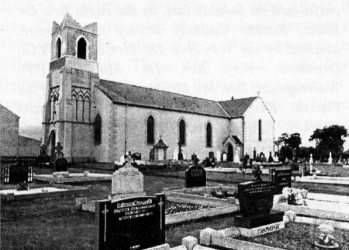
St. Mary's
Church, Derrytrasna, re-erected in 1841 after being
demolished by the Great Wind of January 1839. The church
underwent major renewal in 1986-87, becoming one of the most
beautiful rural churches in the diocese.
CHURCH OF ST. JOHN THE EVANGELIST,
LYLO
In 1814, a small rectangular, white-washed church was
erected on the site of the present edifice by the Rev. Hugh MacConville,
P.P. and at a cost of �350 - a considerable sum in those days. The
little building measured 40 feet in length and 25 feet in width. The
ground for this church and cemetery was given by Mr. William Robinson, a
Protestant gentleman, who owned the townlands of Lylo and Levaghery. The
deed of transfer was finally executed on February 11th. 1822, at the
instance of the Rev. M.J. MacCartan, P.P. This document states that the
site, described as half-an-acre of ground `on which a Roman Catholic
Chapel has lately been built in the townland of Lylo,' was given for the
nominal sum of five shillings `and a pepper-corn in the year, if
demanded.' The burial-ground was further extended in 1856.
The present Church was erected by the Very Rev. L.L.
Morgan, RP., in 1869. The magnificent marble altar was purchased by
Archdeacon MacCartan in 1916, and consecrated by Most Rev. Dr. Mulhern,
Bishop of Dromore. The Church and cemetery were transferred to the
Parish of Moyraverty (Craigavon) on November 3rd, 1971.
ST. JOSEPH'S CHURCH, EDENDERRY
This church was erected through the efforts of Father
Morgan, who secured the site from Mr. Thomas Armstrong; of Edenhall, on
October 10th. 1867, at the yearly rent of �22. Most Rev. Dr. Leahy, O.P.,
Bishop of Dromore, officiated at the dedication of the building on
September 27th. 1868..
A new sacristy was added to the church in 1960, and
the church was transferred to Moyraverty parish in November, 1971. On
Saturday 22nd. July, 1972, a bomb placed in the church exploded, and
virtually demolished the building. The site of the church in Edenderry
was eventually levelled and sold.

Even during the penal days, Seagoe was one of the few
parishes in Dromore Diocese to maintain a school within its borders, as
reported by the Protestant Bishop, in 1731. Later in the same century,
as well as schools built and maintained by the local gentry, a number of
Hedge Schools flourished. No information is to hand about these Hedge
Schools, where the children of the peasantry met `feloniously to learn';
but the report of the Commissioners appointed by the Government in 1824,
the earliest and most comprehensive survey of education in Ireland
before the introduction of the so-called National System in 1831, shows
that no less than twenty-four schools were then in existence in Seagoe.
Six of these were Catholic schools, all in the Hedge School tradition,
and the following information about them has been extracted from the
Commissioners' report:
Ballynamoney:- Pay school. Teacher - William
Brennan; Salary - 8 pounds per annum; School -a - thatched house,
which cost 5 pound; Average attendance - 14 Catholics and 6
Protestants, (12 boys and 8 girls).
Knocknamuckley - Pay school. Teacher - John
MacConville; Salary - 12 pounds to 16 pounds 5s.per annum; School -
a thatched cabin; Average attendance - 11 Catholics and 19
Protestants (all boys).
Drumnagoon - Pay .school. Teacher - John
MacCartney; Salary - 12 pounds per annum; School - a thatched cabin,
which cost 4 pound; Average attendance - 16 Catholics and 20
Protestants (18 girls and 18 boys).
Derryettagh - Pay school. Teacher - Hugh
McMahon; Salary 6 pounds per annum; School -a wretched hovel.
Average attendance; 30 Catholics and 2 Protestants (22 boys and 10
girls).
Ballynary - Pay school. Teacher - John
Campbell; Salary - 18 pounds per annum; School - a hired cabin;
Average attendance - 22 Catholics and 18 Protestants (28 boys and 12
girls).
Derryveen - Pay school Teacher - Ann Bell;
Fees - 2�d per week; School - a miserable cowshed; Average
attendance - 18 Catholics (10 boys and 8 girls).
The pittance described as `salary' was subscribed by
the pupils in small weekly sums similar to the payments made to Ann
Bell, the teacher in Derryveen School. With the setting-up of the
National Board in 1831 these old schools disappeared, though in 1835 the
teacher in a Catholic school in Aghacommon, under the direction of Rev.
L L. Morgan P.P., was still paid his annual salary of � 12 by the
subscriptions of the pupils. In 1838, the oldest portion of the old
school in Aghacommon was built, under the National Board, by Fr. Morgan,
the upper storey being added in 1892.
In 1844, alongside the new church in Derrytrasna and
separated from it by the required wall, Father Morgan established a well
slated and glazed, stone and lime national school. On inspection, the
superintendent of the National Board described the school as being 'new
and in excellent order.' This is in contrast to the two schools which it
replaced, the 'miserable cowshed' in Derryvene and the `wretched hovel'
of Derrytagh, both being supported by Catholics only. Other early 19th.
century pay schools in the area were in Ballynery, a hired cabin
attended chiefly by Catholics; and in Derrytrasna, a mud cabin catering
for 33 Protestant children and 16 Catholic children. While the school at
Derryadd was the official parish school of the Montiaghs, it was
patronised by Mr. Forde who gave two guineas annually towards the
teacher's salary. It was also a pay school as the children paid for
their education. Conditions in the school were poor. The Derrytrasna
school was extended in 1898. The building in Lylo, opened in 1893, and
extended in 1927, replaced an older structure dating from 1879. The
teachers of the Hedge School period were generally men of learning and
culture, and ranked, in the eyes of the people, next in local
importance to the priest. St. John's Primary School. Lylo, was a small
school adjacent to the church. It was transferred to Moyraverty parish
in November 1971. Jerome McAreavey provided a clear and comprehensive
account of the development of the National System of Education in
North-East County Armagh,1831 -60. Particular mention was made of the
difficulties encountered by an outstanding parish priest of Seagoe, the
Very Rev. Laurence Morgan, as he sought to merge a local school into the
national educational system.

In June 1834, Reverend Laurence Morgan, applied for
aid to the National Board for a `recently built' school at Aughacommon,
but it was not connected to the National System until January 1838. No
reason was given for this delay, but there are a number of possible
causes which require investigation in an attempt to explain this three
and a half year delay.
In the first instance Father Morgan stated on his
application that the school was not in operation as `the slates are
putting on at present .... the walls are yet rough .... (there were) no
seats or desks for it'. In applying to the National Board for aid, Fr.
Morgan had expressed the hope `.... we therefore trust as we have made
great exertions in getting up this school in order to have it connected
to the national board, the commissioners will grant us a sum equal to
furnish the school with desks, seats ....'.
There was the implication here that there just was no
money available to' complete the school. This could have
caused the delay in becoming connected to the National Board, for, ten
years later, in December 1844, Fr. Morgan applied for aid for a separate
female school at Aughacommon; on this application there was a note
stating that the former application for this female school had been
cancelled due to the school not being in operation.
The new St. Patrick's Primary School, Aghacommon, was
opened on October 1st. 1962, four weeks after the new St. Paul's
Intermediate School in Lurgan opened. The opening of the new
Intermediate schools for boys and girls ill Lurgan meant that the rural
primary schools would cater only for boys and girls, aged between four
and eleven years. This tended to diminish the strength of the rural
schools, though not their importance. The new St. Patrick's Primary
School replaced the older two-storey school sited beside the cemetery
wall and used now as a business premises. Four octagonally-shaped
classrooms were added to the new school, being completed in May 1972. In
April 1978, an adjacent field was acquired by the parish and is mainly
used as a sports-field for the school.
The new St. Mary's Primary School, Derrytrasna was
opened in September 1969, replacing an older two-storey school in the
church grounds. A sports court adjacent was provided in 1980.
In 1981 the school was connected to the main sewer.

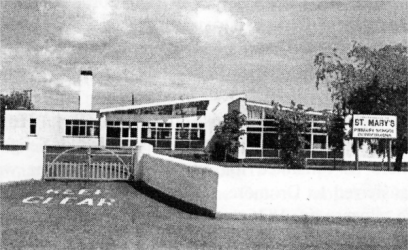
Bright, refreshing appearance of
the new replacement St. Mary's Primary School, Derrytrasna.
PARISH PRIESTS OF SEAGOE
Owing to the destruction of records it is not
possible to give a complete list of the pastors of Seagoe down the ages.
Only the names of a few pre-Reformation clergy have survived and,
following the religious upheavel of the sixteenth century, it is not
until the year 1704 that any information is available about their
successors.
At a general sessions of the peace held in Lurgan on
July 10th. 1704, pursuant to an Act of Parliament passed in the previous
year, Rev. John Byrne was registered as Parish Priest of Seagoe.
On this occasion Father Byrne stated that he was aged 47 years, that he
was ordained by Dr. Thady Keogh, Bishop of Clonfert, at Crigin, Co.
Galway, in I683, and that his place of residence was in the townland of
Ballynamoney. His sureties (in the sum of �50 each) were Christopher
Wilson of Derryinver, and Henry Guinnesse of Lurgan.
It is probable that Father Byrne was P.P. of Seagoe
since his ordination; for, owing to the scarcity of priests at the time,
most of them were appointed parish priests as soon as they were
ordained, and this practice continued (in Dromore Diocese, at least)
until about 1830.
In 1731, the Protestant Bishop in his "Report on the
State of Popery" in Dromore Diocese informed the Government that there
was one priest in Seagoe. Unfortunately this priest's name is not
mentioned, but he may have been Rev. Phelemy MacCosker, P.P., who died
in Ballynamoney in 1744.
In 1766, according to another report to the
Government, Rev. Anthony MacConville was stated to be the only
"Popish Priest" resident in Seagoe. His correct name was Rev. Anthony
MacConwell this being an old form of the surname MacConville. He died in
Ballynamoney in 1792. The name of his immediate successor has not been
found in any of the records, but tradition recalls a Father Byrne, who
is said to have ministered in Seagoe after 1792. He is associated with
the celebration of Mass in a little building on Lark's Hill. in the
Fforde estate at Raughlan. This little structure was used for public
worship by the Catholics for a number of years after the destruction of
the `Mass-house' in Derrymacash by the `Peep-o'-day Boys', in 1796.

In 1809, just after his ordination, Rev. Hugh
MacConville, was appointed Parish Priest of Seagoe, where he
remained for 12 years. In 1821 he was transferred to Dromore, becoming
Vicar General of the diocese in 1836, and dying in 1844. He was
succeeded in Seagoe by Rev. Michael John MacCartan, a native of
Ryan, Newry, who left the parish in 1826, and. in December of the same
year, was appointed Administrator of Clonallon. At the same time Rev.
John MacLeigh, one of the finest Dromore priests of the last
century, was made pastor of Seagoe. He, too, only remained in the parish
for a few years, but left behind him a lasting memorial to his
pastorate, St. Patrick's Church, Aghacommon. In 1831, Father MacLeigh, a
native of the Ballynahinch district, was made Administrator of Clonduff,
and appointed Parish Priest two years later.
Rev. Laurence Morgan was Parish Priest of
Seagoe Parish from August 1831 until his death on the 13th. September,
1878, aged 75 years. Father Morgan is buried in Derrymacash Cemetery
where his grave and headstone are prominent opposite the main door of
St. Patrick's Church. He was the son of Mr. and Mrs. Thomas Morgan of
Lathbirget in the Parish of Forkhill, and the tremendous leadership and
devotion to duty which he readily gave to the Parish of Seagoe during
his forty-seven years as parish priest, entitle him to be regarded as a
truly great priest and the architect of the present parish.
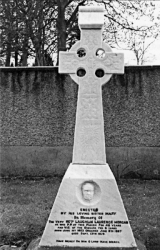
Adjacent to the
entrance door of St. Patrick's Church are the graves of six
parish priests and one curate. The earliest of the graves is
that of Fr. Laurence Morgan, renowned Parish Priest of
Seagoe for 46 years, and a native of Lathbirget, Forkhill.
Father Morgan's pastorate coincided with many barely
tolerable features of nineteenth-century Irish life. The harsh Penal
Laws had restricted the influence of priests to the point that not all
Irish families practised the true Christian way of life. Great increases
in population throughout the country went hand-in-hand with the spread
of poverty, often abject poverty. Too much reliance was being placed on
alcohol by too many Irish people. The condition of the poor worsened
through the 1830s and 1840s, and then came the Famine when the weak were
virtually wiped out in a 12-month period, and many of the strong and
youthful resolved to depart from their native country for ever.
To this scenario of partial gloom, Father Morgan
truly brought Faith, Hope and Charity. His intimate knowledge of the
parishioners could only have been gained through constant visitation to
the many homes of the parish. On three occasions after the funerals of
deceased men, viz. 1851, 1861 and 1867, he noted in the parish register,
"I returned the offering to the widow and her poor children who have
been left in destitute conditions. " Father Mathew, the great Temperance
Priest was an inspired choice of preacher at the dedication of `Trasna
Chapel in 1841, when the huge numbers from far and near who took the
pledge are considered. Father Morgan planned and oversaw the building of
three churches in the parish, viz. St. Mary's, Derrytrasna, the Church
of St. John the Evangelist, Lylo and St. Joseph's Church, Edenderry, as
well as schools at Aughacommon. Such examples of work achieved on behalf
of parishioners represent a much greater array of decisions taken, and
deeds done, which set standards for and on behalf of people who
perceived a worthy leader in their parish priest, whom they generally
referred to as Dr. Morgan.

Rev. James O'Hare was the next Parish Priest
of Seagoe where, owing to the illness of Father Morgan, he had been
Administrator for a few months previously. He built the original
parochial house in 1883. In 1889, he was transferred to the neighbouring
parish of Shankill, where he died nine years later.
On the transfer of Father O'Hare to Lurgan the
Rev. Edward MacCartan was promoted to Seagoe on July 13th. 1889. He
was born in the parish of Upper Drumgooland, and was educated at Cambrai,
France, and the Irish College, Paris, which he entered in 1865. He was
raised to the priesthood by Dr. Leahy in Newry Cathedral on July 18th.
1869, and served as curate' in Clonduff (1869-81) and Mayobridge
(188189). During his ministry of 31 years in the parish, he won the
confidence of the people to whom he was always a wise counsellor and
devoted pastor.
On September 22nd, 1920, the Rev. John O'Hare,
at his own request, was transferred from Dromore to Seagoe as Parish
Priest. For some time previous, the Orangemen of Dromore caused him
considerable annoyance, Father O'Hare being over 65 years of age at the
time. He was a son of James O'Hare, Knocknanarney, Parish of Donaghmore,
where he was born in 1854. He studied for the priesthood in the Irish
College, Paris, and was ordained by Dr. Leahy in Newry Cathedral on
November 18th. 1877.
Rev. John Magee succeeded to the pastorship of
Seagoe on October 3rd. 1934. Father Magee was educated at Maynooth
College, where he was ordained by the late Dr. Walsh, Archbishop of
Dublin, on June 20th. 1909.
Dr. O'Doherty made him Diocesan Chancellor in 1944.
Canon Magee died in Belfast on January 10th. 1950, and was interred in
Aghacommon Cemetery. Shortly after his arrival in the parish, he had the
four churches renovated and redecorated, through the generosity of the
people, as he duly recorded in the parish register at the time. The
schools also received his careful attention.
Rev. Patrick Francis MaeComiskey, was
appointed Parish Priest of Seagoe, on February 5th, 1950, and inducted
three days later by Dean O'Hagan, the Vicar General. He was a native of
Islandmoyle, Parish of Clonduff, and following a distinguished course in
the Irish College, Rome, was ordained in 1918 . Father McComiskey was
appointed Canon, under the title Lanronan, on June 1st. 1956. For some
years before his death he had been Spiritual Director of the Diocesan
Curia of the Legion of Mary. Canon McComiskey died on December 23rd.
1956, and was buried in Derrymacash Cemetery on Saint Stephen's Day,
1956.
Rev. James Boyd was appointed Parish Priest of
Seagoe on January 21st. 1957. He was born in 1898, in the parish of
Magheradroll (Ballynahinch). He was ordained a priest in 1924, and
shortly afterwards was appointed as a curate in Newry Parish. After
thirty years as a curate in Newry, he was appointed as Administrator in
that same parish on March 21st. 1955. Two years later, he was appointed
Parish Priest of Seagoe. He was for many years Spiritual Director of the
Holy Family Confraternity in Newry, and, at the time of his death, was
Spiritual Director of the northern diocesan Curia of the Legion of Mary.
Father Boyd was tragically killed in a road accident on the Belfast
Road, near Newry, on September 21st. 1960. He was buried on September
23rd. 1960, in Derrymacash Cemetery.
Very Rev. Dean Bernard J. Mooney, the
distinguished parish priest of Seagoe who preceded Canon Joseph Pettit,
had served for three years as a curate in the parish in the early 1930s.
He was born in Ballylone, Ballynahinch, on 1st. December, 1897, was
educated at St. Colman's College, Newry, arid at Maynooth College, where
he was ordained in 1923. Following post-graduate studies at University
College, Dublin, he was on the teaching staff of St. Colman's College,
Newry, from 1924 to 1930.
Dean Mooney celebrated the Golden Jubilee of his
ordination being the principal celebrant of a concelebrated Mass which
took place in the open air at an altar erected in front of the Parochial
House, Derrymacash. The accompanying special sermon was preached by the
Very Rev. Canon Michael O'Rourke, P.P., Banbridge. Dean Mooney retired
from his parish, due to ill health, in June 1975, and died in the
Alexian Brothers' Nursing Home, Warrenpoint, on October 11th. the same
year.

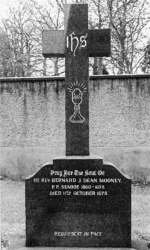
Dean Bernard
Mooney was a native of Ballylone, Ballynahinch, anc was
known throughout the northern counties for his Gaelic
scholarship. His learned contributions to journals
specialising in the derivation of placenames are valued
highly by present-day writers.
Canon Joseph Pettit, who had been Parish Priest of
Lower Drumgooland, 1965-75, was appointed Parish Priest of Seagoe, on
July 5th. 1975. He was the brother of Canon Thomas Pettit, former
President of St. Colman's College, Newry, and Parish Priest of Tullylish.
Canon Pettit was greatly beloved by his parishioners and when in Seagoe,
was the only living person to have a G.A.A. ground named in his honour,
that of Pettit Park in Rostrevor. During his pastorate, two major church
initiatives were undertaken. In the period, 1976-79, a new bell-tower
was erected in St. Patrick's Church, Aghacommon, and a bell installed
and blessed. In 1982-83, the church was refurbished and a splendid
pine-timbered ceiling installed. In July, 1987, he oversaw a major
reconstruction scheme in St. Mary's Church, Derrytrasna. In 1990, Dean
Joseph Pettit retired as parish priest and, for a short period, served
as curate in Derrytrasna. He died on January 3rd. 1996, and is interred
in the priests' burial plot facing the front entrance to St. Patrick's
Church, Aghacommon.
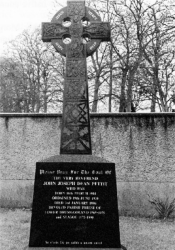
Dean Joseph
Pettit was born in Warrenpoint and was a devoted pastor
in many Dromore parishes. He had a long and
distinguished record as an able administrator in the
Gaelic Athletic Association at club, county and
provincial levels. Pettit Park, in Rostrevor, bears his
name.
In August 1990, following Dean Pettit's retirement,
Very Reverend Fr. Cathal Jordan, P.P. Dromore, was appointed Parish
Priest of Seagoe. Since his appointment, Canon Jordan has completed a
wide range of impressive initiatives and improvements. A new parochial
house, erected on the site of the former house, was completed in
September 1992. This was a most appropriate step to take as the
housing-stock throughout the parish was, and is, undergoing an almost
complete transformation. A major scheme of refurbishment and extension
was completed in the cemetery adjoining St. Patrick's, a handsome
retaining wall was built with much voluntary work. St. Patrick's has
been completely re-roofed, and St. Patrick's School and grounds updated
with pupil safety as the focus. It is always inappropriate to restrict
the pen-portrait of a parish priest to an account of building
initiatives and church refurbishments undertaken. Canon Jordan has
achieved major improvements in these areas, yet it is in the spheres of
spirituality, pastoral care of the young and elderly, and parish
leadership where his pastorate has been focused in these past years of
enormous change and intense challenge.

Since 1990, following the completion of an array of
new housing developments, the parishioner profile has greatly changed,
unusual in a rural parish which has now taken on the role of a dormitory
village for people who work further afield. That said, the churches,
schools and cemeteries remain the foci of parish life in a district
which greatly manifests the upsurge in economic well-being which
characterised the final two decades of the 20th. century.
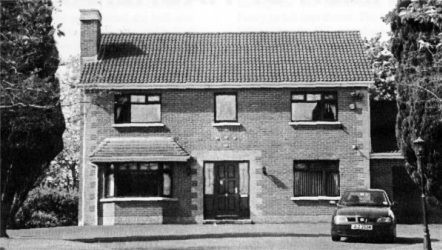
New
Parochial House, Derrymacash, planned and erected by
Canon Jordan within two years of his appointment to
Seagoe Parish.
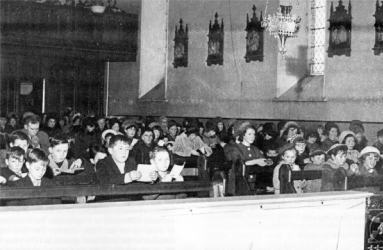
Parishioners at
Sunday morning Mass, 1964. This was pre-Vatican Council and
pre-refurbishment of the entire church interior. St.
Patrick's, Derrymacash, in the ensuing forty
years has undergone great change in church improvement and
population profile.
 |